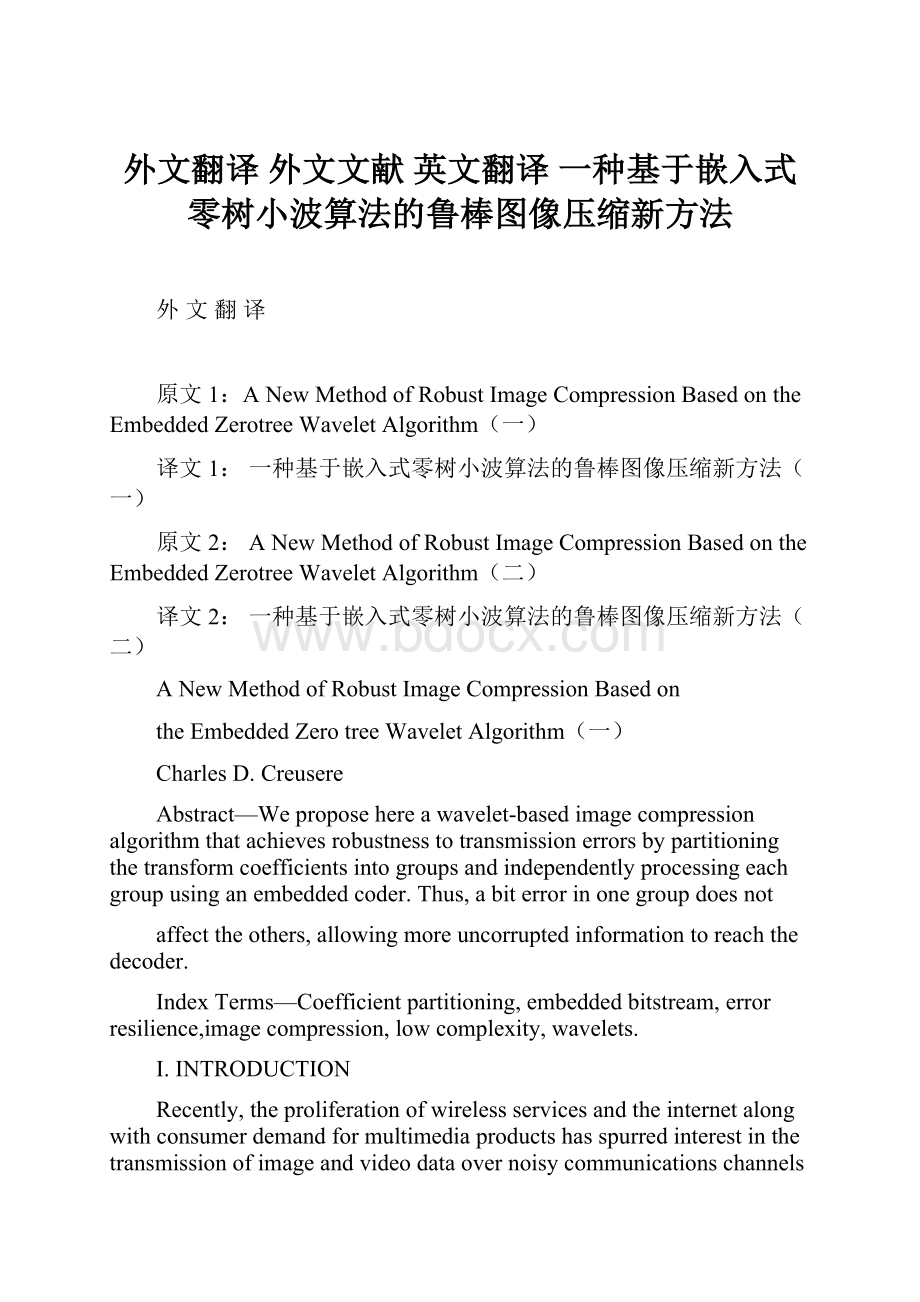外文翻译 外文文献 英文翻译 一种基于嵌入式零树小波算法的鲁棒图像压缩新方法.docx
《外文翻译 外文文献 英文翻译 一种基于嵌入式零树小波算法的鲁棒图像压缩新方法.docx》由会员分享,可在线阅读,更多相关《外文翻译 外文文献 英文翻译 一种基于嵌入式零树小波算法的鲁棒图像压缩新方法.docx(10页珍藏版)》请在冰豆网上搜索。

外文翻译外文文献英文翻译一种基于嵌入式零树小波算法的鲁棒图像压缩新方法
外文翻译
原文1:
ANewMethodofRobustImageCompressionBasedontheEmbeddedZerotreeWaveletAlgorithm
(一)
译文1:
一种基于嵌入式零树小波算法的鲁棒图像压缩新方法
(一)
原文2:
ANewMethodofRobustImageCompressionBasedontheEmbeddedZerotreeWaveletAlgorithm
(二)
译文2:
一种基于嵌入式零树小波算法的鲁棒图像压缩新方法
(二)
ANewMethodofRobustImageCompressionBasedon
theEmbeddedZerotreeWaveletAlgorithm
(一)
CharlesD.Creusere
Abstract—Weproposehereawavelet-basedimagecompressionalgorithmthatachievesrobustnesstotransmissionerrorsbypartitioningthetransformcoefficientsintogroupsandindependentlyprocessingeachgroupusinganembeddedcoder.Thus,abiterrorinonegroupdoesnot
affecttheothers,allowingmoreuncorruptedinformationtoreachthedecoder.
IndexTerms—Coefficientpartitioning,embeddedbitstream,errorresilience,imagecompression,lowcomplexity,wavelets.
I.INTRODUCTION
Recently,theproliferationofwirelessservicesandtheinternetalongwithconsumerdemandformultimediaproductshasspurredinterestinthetransmissionofimageandvideodataovernoisycommunicationschannelswhosecapacitiesvarywithtime.Insuchapplications,itcanbeadvantageoustocombinethesourceandchannelcoding(i.e.,compressionanderrorcorrection)processesfrombothacomplexityandaninformationtheorystandpoint.Inthiswork,weintroduceaformoflow-complexityjointsourcechannelcodinginwhichvaryingamountsoftransmissionerrorrobustnesscanbebuiltdirectlyintoanembeddedbitstream.TheapproachtakenheremodifiesShapiro’sembeddedzerotreewavelet(EZW)imagecompressionalgorithm,butthebasicideacanbeeasilyappliedtootherwavelet-basedembeddedcoderssuch
Thispaperisorganizedasfollows.InSectionII,wediscusstheconventionalEZWimagecompressionalgorithmanditsresistancetotransmissionerrors.Next,SectionIIIdevelopsournew,robustcoderandexplorestheoptionsassociatedwithitsimplementation.InSectionIV,weanalyzetheperformanceoftherobustalgorithminthepresenceofchannelerrors,andweusetheresultsofthisanalysistoperformcomparisonsinSectionV.Finally,implementationandcomplexityissuesarediscussedinSectionVI,followedbyconclusionsinSectionVII.
II.EZWIMAGECOMPRESSION
Afterperformingawavelettransformontheinputimage,theEZWencoderprogressivelyquantizesthecoefficientsusingaformofbitplanecodingtocreateanembeddedrepresentationoftheimage—i.e.,arepresentationinwhichahighresolutionimagealsocontainsallcoarserresolutions.ThisbitplanecodingisaccomplishedbycomparingthemagnitudesofthewaveletcoefficientstoathresholdTtodeterminewhichofthemaresignificant:
ifthemagnitudeisgreaterthanT,thatcoefficientissignificant.Asthescanningprogressesfromlowtohighspatialfrequencies,a2-bsymbolisusedtoencodethesignandpositionofallsignificantcoefficients.Thissymbolcanbea+or-indicatingthesignofthesignificantcoefficient;a“0”indicatingthatthecoefficientisinsignificant;orazerotreeroot(ZTR)indicatingthatthecoefficientisinsignificantalongwithallofthefinerresolutioncoefficientscorrespondingtothesamespatialregion.TheinclusionoftheZTRsymbolgreatlyincreasesthecodingefficiencybecauseitallowstheencodertoexploitinterscalecorrelationsthathavebeenobservedinmostimages.Aftercomputingthe“significancemap”symbolsforagivenbitplane,resolutionenhancementbitsmustbetransmittedforallsignificantcoefficients;inourimplementation,weconcatenatetwoofthesetoformasymbol.Priortotransmission,thesignificanceandresolutionenhancementsymbolsarearithmeticallyencodedusingthesimpleadaptivemodeldescribedinwithafoursymbolalphabet(plusonestopsymbol).ThethresholdTisthendividedbytwo,andthescanningprocessisrepeateduntilsomerateordistortiontargetismet.Atthispoint,thestopsymbolistransmitted.Thedecoder,ontheotherhand,simplyacceptsthebitstreamcomingfromtheencoder,arithmeticallydecodesit,andprogressivelybuildsupthesignificancemapandenhancementlistintheexactsamewayastheywerecreatedbytheencoder.
Theembeddednatureofthebitstreamproducedbythisencoderprovidesacertaindegreeoferrorprotection.Specifically,alloftheinformationwhicharrivesbeforethefirstbiterroroccurscanbeusedtoreconstructtheimage;everythingthatarrivesafterislost.Thisisindirectcontrasttomanycompressionalgorithmswhereasingleerrorcanirreparablydamagetheimage.Furthermore,wehavefoundthattheEZWalgorithmcanactuallydetectanerrorwhenitsarithmeticdecoderterminates(bydecodingastopsymbol)beforereachingitstargetrateordistortion.Itiseasytoseewhythismusthappen.Considerthattheencoderanddecoderusethesamebackwardadaptivemodeltocalculatetheprobabilitiesofthefivepossiblesymbols(fourdatasymbolsplusthestopsymbol)andthattheseprobabilitiesdirectlydefinethecodewords.Notsurprisingly,thelengthofasymbol’scodewordisinverselyproportionaltoitsprobability.Ifacompletelyrandombitsequenceisfedintothearithmeticdecoder,thentheprobabilityofdecodinganysymboliscompletelydeterminedbytheinitialstateoftheadaptivemodel—i.e.,theprobabilityweightingdefinedbythemodelisnot,ontheaverage,changedbyarandominput.
InourimplementationoftheWittenetal.arithmeticcoder,wesetMax_frequencyequalto500andmaintainthestopsymbolprobabilityat1/cum_freq.Becausecum_freq(thesumofthefrequencycountsofallsymbols)isdividedbytwowheneveritexceedsMax_frequency,theprobabilityofdecodingastopsymbolstaysmostlybetween1/250and1/500.Thus,ifarandombitstreamisfedintothedecoderaftertrainingittothispoint,anaverageof250to500symbolswillbeprocessedbeforethestopsymbolisdecoded.Thebitstreamiscorrectlyinterpretedaslongasthedecoderissynchronizedwiththeencoder,butthissynchronizationislostshortlyafterthefirsterroroccurs.Oncethishappens,theincomingbitstreamlooksrandomtothedecoder(themoreefficienttheencoder,themorerandomitwillappear).Sinceeachsymbolisrepresentedinthecompressedimagebybetweenoneandtwobits,thedecodershouldself-terminatebetween31and125bytesafteranerroroccurs.Experimentally,wehavefoundthatthearithmeticdecoderoverrunistypicallybetween30and50bytes,whichisconsistentwiththetheoreticalrange,sincemostoftheseterminationstookplacewhiledecodingthehighlycompressedsignificancemap.Iftheoverrunissmallcomparedtothenumberofbitscorrectlydecoded,itdoesnotsignificantlyaffectthequalityofthereconstructedimage.Whilesomeerroneousinformationisincorporatedintothewaveletcoefficients,thebitplanescanningstructureensuresthatitiswidelydispersedspatially,makingitvisuallyinsignificantintheimage.
作者:
CharlesD.Creusere
国籍:
美国
出处:
图像处理电机及电子学工程师联合会1997年第10期1436-1442页
ISSN1057-7149
一种基于嵌入式零树小波算法的鲁棒图像压缩新方法
(一)
CharlesD.Creusere
摘要----本文Weproposeawavelet-basedimagecompressionalgorithmthatachievesrobustnesstotransmissionerrorsbypartitioningthetransformcoefficientsintogroupsandindependentlyprocessingeachgroupusinganembeddedcoder.提出了一种基于小波变换的图像压缩算法,通过分割由系数转变成的群组和独立使用内嵌编码器处理每个分组,实现了传输错误的鲁棒性。
这样,一个分组的误码不会影响到其他的分组,允许更多未损坏的信息到达解码器
标引词Thus,abiterrorinonegroupdoesnotaffecttheothers,allowingmoreuncorruptedinformationtoreachthedecoder--系数分割,内嵌码流,错误恢复,图像压缩,低复杂性,小波。
一、引言
最近,受到无线服务和互联网的增殖、消费者对多媒体产品的需求的影响,人们对图像和视频数据在含噪通信信道的传输的兴趣日益加深。
基于这种应用环境,无论从复杂性还是信息理论的角度,合并信源和信道编码(即压缩和纠错)流程都是十分有利的。
在这项工作中,我们采用了一种低复杂度、信源信道联合编码的形式,不同数量的传播错误的鲁棒性可直接内建在一个内嵌比特流中。
在这里采用的方法修改了Shapiro的嵌入式零树小波(零树)图像压缩算法,但其基本思想可以很容易地适用于其他基于小波变换的嵌入式编码,例如SaidandPearlman的基于小波变换的嵌入式编码和TaubmanandZakho的基于小波变换的嵌入式编码。
使用这种方法已经得到了一些初步成果。
本文组织如下。
在第二节,我们将讨论传统的EZW图像压缩算法及其对传输误差的影响。
接下来,我们在第三节开发新的鲁棒性编码器并且探索相关实施编码器的方案。
在第四节,我们分析在存在通道错误的情况下鲁棒EZW算法的性能,并且我们在第五节使用这种分析的结果充当对比。
最后,在第六节中讨论执行和复杂性问题,在第七节记录随后的结论。
二、EZW图像压缩
一幅输入的图像经过小波变换后,EZW编码器利用位平面编码创造一个图像的嵌入式描绘的形式来逐步量化系数,也就是说,高分辨率的描绘还包含所有粗分辨率。
此位平面编码是通过比较小波系数和阈值T的大小来确定哪些系数是重要的:
如果小波系数比T大,则这个小波系数是重要的。
由于扫描进程是从低空间频率到高空间频率,一个2bit的字符被用来编码所有重要系数的标记和位置。
这个字符可以是用+或-来描述重要系数的标记;一个“0”表明该系数是微不足道的;一个零树的根(ZTR)表明该系数与在同一空间区域中所有高分辨度相应的系数一样是微不足道的。
ZTR字符的引入大大提高了编码效率,因为它允许编码器利用已在大多数图像中被观察到的层间之间的相关性。
在计算操作给定位平面的“重要性图表”字符后,分辨率增强位必须被传输到所有重要的系数,在我们的实际操作中,我们连接两个系数来形成字符。
在传输之前,重要性图表字符和分辨率增强字符使用简单的自适应模型描述,以四个字母符号来进行算术编码(增加一个停止字符)。
然后阈值T除以2,并且反复进行扫描过程直至满足某一码率或失真率目标。
此时,传输停止符号。
另一方面,解码器仅仅只接收来自编码器的比特流,对其进行解码,并逐步用和编码器建立重要性图表的列出方式完全相同的列出方式建立重要性图表和增强字符。
编码器产生的比特流的内嵌性质提供一定程度上的误差防护。
具体而言,第一个位错误到达之前的所有信息可以用来重建图像;一切在丢失后都可以到达。
这是许多一个错误就可能对图像造成不可弥补的损害的压缩算法所不能相比的。
此外,我们已经发现,EZW算法实际上在实现其目标码率或失真之前,当其解码器终止(通过解码停止符号)的时候可以检测到存在的错误。
我们很容易理解为什么这项算法功能必须存在。
我们考虑编码器和解码器使用相同的落后的自适应模型来计算5个可能字符(4数据字符加上停止字符)的概率,并且这些概率直接确定码字。
毫不奇怪,一个字符的码字长度和其概率是成反比的。
如果将一个完全随机位序列送入解码器,那么任何字符的解码概率完全取决于自适应模型的初始状态,也就是说,一般来说,一个随机的输入并不改变概率权重的模型定义。
在我们使用Wittenetal编码器时,我们设置Max_frequency为500且保持停止字符概率1/cum_freq。
由于cum_freq(所有的字符的频率的总和)每逢超过Max_frequency都要除以2,译码停止字符的概率主要是在1/250~1/500之间。
因此,如果在到达这一点后将一个随机码流是送入解码器,在编码停止字符之前平均250到500个字符会被处理。
比特流可以正确理解为编码器和解码器的同步,但这种同步在第一个错误发生后不久将会失去。
一旦发生这种情况,比特流将被看做随机输入送入解码器(越是有效率的编码器,越会出现随机输入)。
因为每个符号在压缩图像中代表1至2位,编码器错误发生后的31至125字节时会自行终止。
通过实验,我们发现,解码器溢出通常是在30至50字节时,它与理论范围是一致的,因为这些终止会发生在解码高度压缩的重要图的时侯。
如果溢出和正确解码的位数相比是比较小的,它并不会显着影响的重建图像的质量。
虽然一些错误的信息会被纳入小波系数中,位平面扫描结构会确保它被广泛地分散在空间中,使其在图像中毫无意义。
ANewMethodofRobustImageCompressionBasedon
theEmbeddedZerotreeWaveletAlgorithm
(二)
CharlesD.Creusere
III.ROBUSTEZW(REZW)ALGORITHM
ThebasicideaoftheREZWimagecompressionalgorithmistodividethewaveletcoefficientsupintoSgroupsandthentoquantizeandcodeeachofthemindependentlysothatS